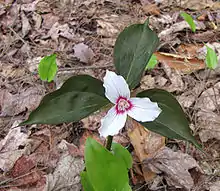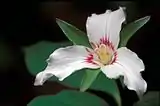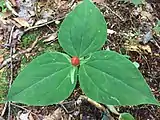Trillium undulatum
Trillium undulatum, the painted trillium,[3] is a species of flowering plant in the family Melanthiaceae. It is also known as painted lady (not to be confused with a painted lady butterfly), smiling wake robin,[4] or trille ondulé[5] in French. The plant is found from Ontario in the north to northern Georgia in the south and from Michigan in the west to Nova Scotia in the east.[2][6] It demands strongly acidic, humus-rich soils and tends to be found in the shade of acid-loving trees such as eastern white pine, red maple, red spruce and balsam fir. Although the soils that support it have low base saturation, this species was found to have relatively high levels of calcium, magnesium, and especially potassium in its foliage.[5][7]
| Painted trillium | |
|---|---|
 | |
| Scientific classification | |
| Kingdom: | Plantae |
| Clade: | Tracheophytes |
| Clade: | Angiosperms |
| Clade: | Monocots |
| Order: | Liliales |
| Family: | Melanthiaceae |
| Genus: | Trillium |
| Species: | T. undulatum |
| Binomial name | |
| Trillium undulatum Willd. 1801 | |
| Synonyms[2] | |
| |
Trillium undulatum is a perennial herbaceous plant that spreads by means of underground rhizomes. There are three large leaf-like bracts arranged in a whorl about a scape that rises directly from the rhizome. Bracts are ovate, each with a definite petiole.[8]
Flowering occurs from late April to the end of June.[5] The single, terminal flower is pedicellate with three sepals and three petals. The petals are wavy-margined and white with a central red to reddish purple splotch at the base of the flower.[9]
After anthesis, if the flower was successfully pollinated, a single fruit develops. Initially the fruit is green, ripening to a bright red by mid to late summer. The fruit is a berry-like capsule, 1 to 2 cm (0.5 to 1 in) long.[9][10] No other North American Trillium species has a fruit of this size and shape.
Numerous abnormal forms have been reported[11] including variants with multiple whorls of bracts, enormous sepals, or four or more parts (instead of the usual three), the latter being somewhat common in T. undulatum.[12] A form with unmarked white petals occurs in the southern Appalachian Mountains.[13]
- Trillium undulatum
 T. undulatum flowering in the Appalachian Mountains in western Virginia USA
T. undulatum flowering in the Appalachian Mountains in western Virginia USA T. undulatum fruiting along the Lake Mansfield Trail in Vermont USA
T. undulatum fruiting along the Lake Mansfield Trail in Vermont USA_Vermont_2019-07-18.jpg.webp) An unusual individual with four leaves and four sepals
An unusual individual with four leaves and four sepals Geographical distribution of T. undulatum in the USA
Geographical distribution of T. undulatum in the USA
References
- "Trillium undulatum". NatureServe Explorer. NatureServe. Retrieved 2008-05-02.
- "Trillium undulatum". World Checklist of Selected Plant Families (WCSP). Royal Botanic Gardens, Kew. Retrieved 11 October 2019.
- "Trillium undulatum". Natural Resources Conservation Service PLANTS Database. USDA. Retrieved 15 December 2015.
- Keyes, Florence J. (January 1927). "Trillium grandiflorum in Maine". Rhodora. New England Botanical Club, Inc. 29 (337): 15. Retrieved 8 September 2020.
- Case Jr., Frederick W. (2002). "Trillium undulatum". In Flora of North America Editorial Committee (ed.). Flora of North America North of Mexico (FNA). 26. New York and Oxford – via eFloras.org, Missouri Botanical Garden, St. Louis, MO & Harvard University Herbaria, Cambridge, MA.
- "Trillium undulatum". County-level distribution map from the North American Plant Atlas (NAPA). Biota of North America Program (BONAP). 2014. Retrieved 11 October 2019.
- T.G. Siccama, F.H. Bormann and T.E. Likens. The Hubbard Brook Ecosystem Study: Productivity, Nutrients and Phytosociology of the Herbaceous Layer. Ecological Monographs Vol.40, No. 4, Autumn 1970.
- O'Connor, R. P.; Penskar, M. R. (2004). "Special plant abstract for Trillium undulatum (painted trillium)" (PDF). Lansing, MI, USA: Michigan Natural Features Inventory. Retrieved 17 July 2019.
- Stritch, Larry. "Painted Trillium (Trillium undulatum)". United States Forest Service. Retrieved 1 July 2019.
- "Painted Trillium (Trillium undulatum)". Adirondacks Forever Wild. Retrieved 8 July 2019.
- Deane, Walter (February 1908). "Some Teratological Forms of Trillium undulatum". Rhodora. New England Botanical Club, Inc. 10 (10): 21–24. JSTOR 23294015.
- Fernald, M. L. (1943). "Trillium undulatum Willd., forma Cleavelandicum (Wood), comb. nov". Rhodora. 45: 517. Retrieved 8 November 2019.
- Patrick, Thomas S. (1985). "Trillium undulatum forma enotatum, a new petal color form of the painted trillium". Rhodora. 87: 157–158. Retrieved 8 November 2019.
External links
- Painted Trillium Trillium undulatum, Ontario Wildflowers
- Citizen science observations for Painted Trillium at iNaturalist
| Wikimedia Commons has media related to Trillium undulatum. |

